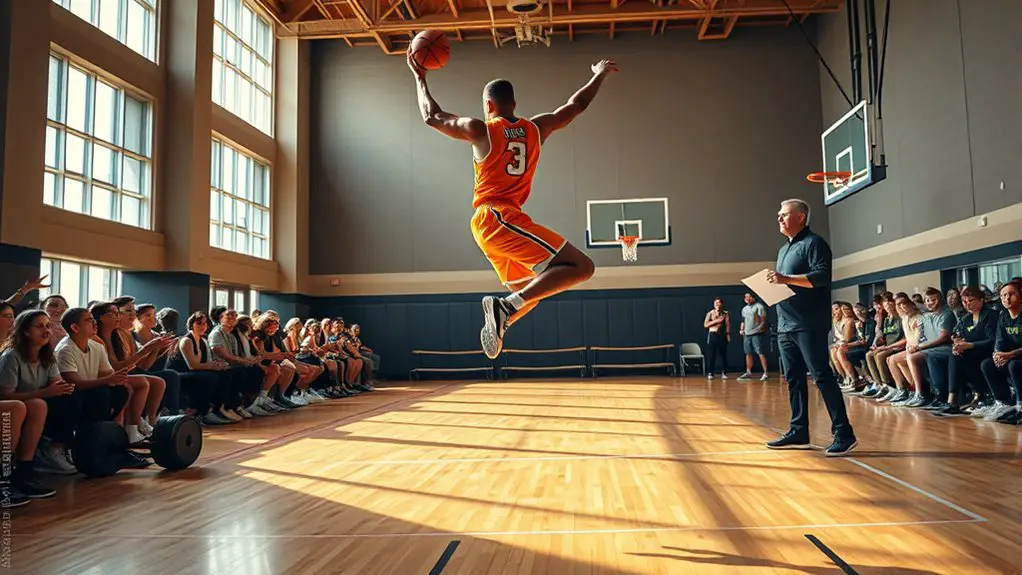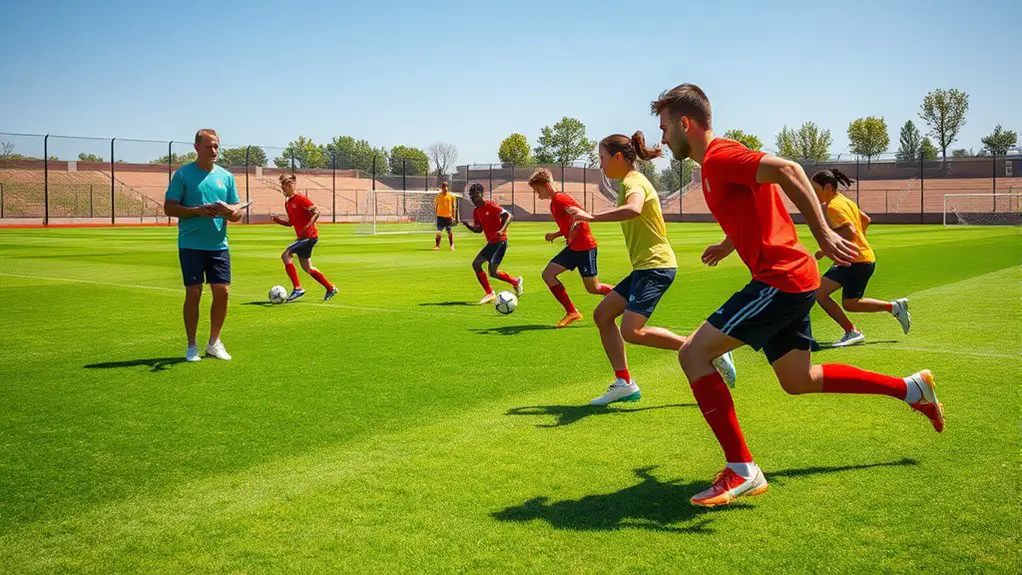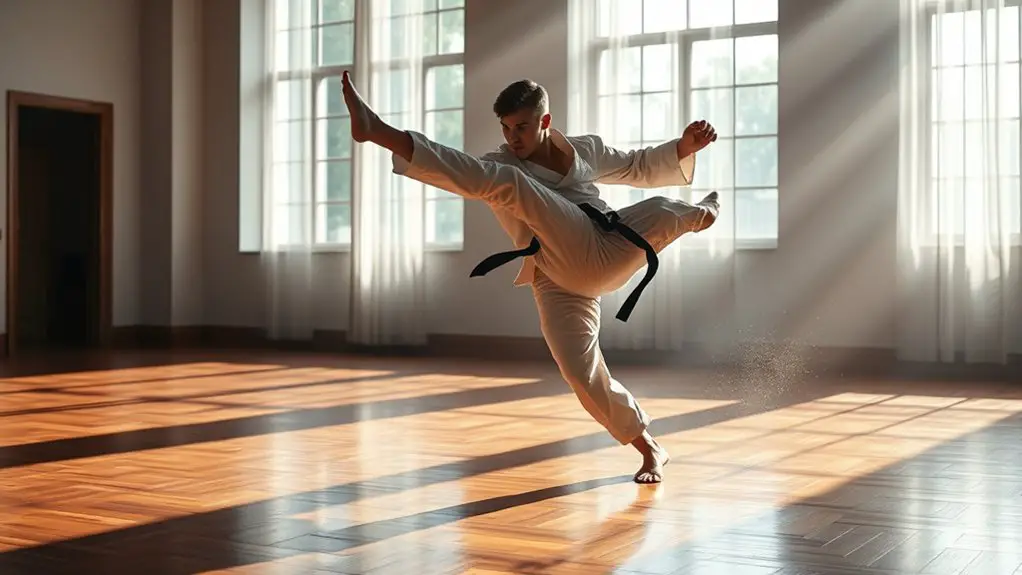To train for full-body power in basketball, focus on strength training, plyometric exercises, and Olympic lifts. Incorporate explosive movements like jump squats and box jumps to enhance your power. Don't forget core strength; stability exercises like planks will keep you balanced during intense plays. Implement resistance training to build muscle, and don't overlook flexibility and mobility workouts to prevent injury. As you refine your workout routine, you'll discover more techniques to elevate your game.
Understanding Full-Body Power in Basketball
When you think about basketball, you might focus on shooting or dribbling, but understanding full-body power is vital for elevating your game. Full body mechanics play a significant role in how you generate explosive movements on the court. It's not just about your arms or legs; your entire body needs to work together harmoniously.
When you explode off the ground to dunk or sprint down the court, your core, legs, and arms should all contribute to that power. Think of each movement as a chain reaction: a strong base leads to better jumps and quicker sprints.
To truly harness this power, focus on drills that engage multiple muscle groups, enhancing your coordination and strength. Practicing explosive movements, like jump squats or plyometric exercises, will help you build that full-body synergy, allowing you to dominate the game and enjoy the freedom of athletic expression. Additionally, incorporating plyometric training into your regimen can significantly improve your overall performance on the court.
Importance of Strength Training
Building full-body power doesn't just happen on the court; it requires a solid foundation of strength training. By prioritizing strength, you'll gain several key benefits that directly translate to your game. Here are three strength benefits you can expect from consistent training:
Building a strong foundation through consistent strength training is essential for maximizing your performance on the court.
- Increased Explosiveness: Strength training enhances your muscle power, essential for those quick jumps and fast breaks.
- Improved Endurance: A stronger body can handle more intense play, allowing you to maintain high energy throughout the game.
- Injury Prevention: Building strength helps stabilize joints and muscles, reducing your risk of injury during those high-impact moments. Additionally, incorporating Olympic lifts into your routine can significantly boost your overall power.
To reap these benefits, consider your training frequency. Aim for at least three strength sessions a week, ensuring you target all major muscle groups. With dedication to strength training, you'll feel the freedom to dominate on the court!
Plyometric Exercises for Explosiveness
Plyometric training can greatly boost your explosiveness on the court. You'll want to focus on key exercises that enhance your power while keeping safety and technique in mind. Let's explore the benefits and best practices to maximize your performance. Additionally, incorporating proper technique is essential to maximize explosive power and reduce injury risk during your plyometric workouts.
Benefits of Plyometric Training
Since basketball demands quick bursts of speed and explosive movements, incorporating plyometric training into your routine can greatly enhance your performance. The plyometric benefits are immense, helping you develop the explosive power necessary to dominate the court. Here are three key advantages:
- Improved Speed: Plyometric exercises boost your ability to accelerate quickly, giving you an edge on fast breaks.
- Increased Vertical Jump: These drills enhance your jumping ability, allowing you to reach the basket with ease and snag rebounds.
- Enhanced Agility: Plyometrics improve your overall agility, making it easier to change direction during intense play.
Embracing plyometric training not only elevates your game but also brings a sense of freedom in your movements. Get ready to release your potential!
Key Plyometric Exercises
Incorporating key plyometric exercises into your training routine can greatly boost your explosiveness on the basketball court. Start with box jumps to enhance your jump techniques; they'll help you spring off the ground with power. Depth jumps are another fantastic choice, improving your ability to generate force quickly. Don't forget about tuck jumps, which promote both height and body control. As you work on these exercises, pay close attention to your landing mechanics to guarantee you stay agile and injury-free. Integrating these plyometric movements will not only increase your vertical leap but also enhance your overall athletic performance. Embrace the freedom that comes with explosive power, and watch your game transform!
Safety and Technique Tips
While boosting your explosiveness with plyometric exercises, it's crucial to prioritize safety and proper technique. Remember, you want to release your power without risking injury. Here are some key safety precautions and technique refinement tips to keep in mind:
- Warm-Up Properly: Always start with dynamic stretches to prep your muscles and joints.
- Focus on Landing Mechanics: Land softly on the balls of your feet, bending your knees to absorb impact and maintain balance.
- Progress Gradually: Increase intensity and complexity only when you feel comfortable with your current level; don't rush the process.
Olympic Lifts for Maximum Power
If you want to boost your basketball power, Olympic lifts can be a game-changer. These lifts not only enhance your strength but also improve your explosive movements on the court. Let's explore the benefits, key techniques, and how to effectively incorporate them into your training routine. Mastering proper technique is essential for maximizing your lifting efficiency and minimizing injury risk.
Benefits of Olympic Lifts
Olympic lifts, such as the clean and jerk or snatch, can greatly enhance your basketball power by developing explosive strength and coordination. These lifts promote muscle recruitment across your entire body, giving you the edge during games. Here are three key benefits:
- Increased Explosiveness: Olympic lifts train your fast-twitch muscle fibers, essential for quick jumps and sprints.
- Improved Coordination: The dynamic nature of these lifts enhances your overall body control, helping you move more efficiently on the court.
- Functional Strength: By mimicking the movements used in basketball, Olympic lifts prepare your body for real-game situations, enabling you to perform at your best.
Incorporating these lifts into your training can empower your game and release your full potential.
Key Olympic Lift Techniques
Mastering key techniques for Olympic lifts is essential for maximizing your basketball power. Start with the snatch technique, focusing on explosive movements to enhance your speed and agility. The clean technique builds strength and helps with grip strength, vital for ball handling. Don't forget the jerk technique, which develops overhead power and stability. Incorporate lift variations to keep your training fresh and engaging, allowing your body to adapt. Aim for consistent training frequency to see real progress, but prioritize injury prevention by using proper form and warm-ups. By honing these techniques, you'll reveal your full potential on the court, allowing you to dominate and enjoy the freedom of performance.
Incorporating Olympic Lifts
Incorporating Olympic lifts into your training routine can greatly boost your basketball power. These lifts enhance your explosiveness, which is vital for making those game-changing plays. Here are three key Olympic lift variations you should consider:
- Clean and Jerk: This lift promotes full-body strength and speed, essential for quick movements on the court.
- Snatch: It improves coordination and power, helping you leap higher for rebounds.
- Power Clean: This one focuses on developing explosive strength, which translates to faster sprints and jumps.
To maximize your gains, utilize lift progression techniques. Start with lighter weights to master form, then gradually increase the load. By incorporating these lifts effectively, you'll feel more dynamic and powerful in your game.
Core Strength and Stability
While many players focus on their shooting and dribbling skills, developing core strength and stability is equally essential for enhancing overall basketball performance. A strong core helps you maintain balance, absorb contact, and execute explosive movements on the court. To improve core engagement, incorporate stability exercises into your training routine. Think planks, Russian twists, and medicine ball slams. These movements not only strengthen your midsection but also enhance your ability to control your body during games.
As you work on your core, remember that stability is key. Engaging your core means activating those muscles to support your spine and pelvis. This stability allows you to pivot, jump, and sprint with confidence. Don't underestimate the impact of a strong core; it's the foundation of your athletic abilities. By prioritizing core strength, you'll open up greater freedom of movement and elevate your game to new heights. Additionally, developing a strong core aids in preventing injuries, ensuring you can perform at your best without setbacks.
Agility Drills to Enhance Speed
To elevate your game, you need to focus on agility drills that boost your speed on the court. Ladder drills can enhance your quickness, while cone drills improve your ability to change direction swiftly. Don't forget about plyometric exercises—they're key for developing explosive speed. Additionally, incorporating strength training into your routine can further enhance your power for quick directional changes.
Ladder Drills for Quickness
Ladder drills are an excellent way to boost your quickness on the basketball court, as they focus on foot speed, coordination, and agility. By incorporating varied ladder patterns, you'll enhance your performance in quickness drills and gain that edge over your competition. Here are three effective ladder drills to try:
- In-and-Out: Step into each square with your feet, alternating quickly to improve your foot speed.
- Lateral Shuffle: Move side-to-side, keeping your hips low to work on lateral quickness.
- Single-Leg Repeats: Hop through the ladder on one leg, which builds balance and stability.
Practice these regularly, and you'll notice improved quickness, allowing you to maneuver effortlessly on the court. Embrace the freedom that comes with your newfound agility!
Cone Drills for Agility
Cone drills are an essential part of any basketball training program, as they help you develop agility and improve your speed on the court. By experimenting with cone placement, you can create various drill variations that suit your needs. Set up different cone patterns to challenge yourself with agility challenges that require quick directional changes. For instance, sprint from one cone to another, then laterally shuffle to the next, focusing on speed enhancement as you navigate the setup. Incorporating these drills into your routine can remarkably boost your on-court performance. So grab some cones, get creative, and make each session an opportunity to sharpen your skills while enjoying the freedom of movement that basketball offers!
Plyometric Exercises for Speed
While agility drills are essential for improving your speed on the basketball court, plyometric exercises can take your performance to the next level. Incorporating jump training into your routine not only boosts your explosive power but also enhances your overall speed. Here are three effective plyometric exercises to include in your speed drills:
- Box Jumps: Propel yourself onto a sturdy box, focusing on landing softly to build strength and balance.
- Depth Jumps: Step off a box, then immediately jump upward upon landing, reinforcing quick reaction times.
- Broad Jumps: Leap forward as far as you can, emphasizing distance and speed with each jump.
These exercises will help you release your full potential and elevate your game on the court.
Implementing Resistance Training
To build explosive power on the basketball court, incorporating resistance training into your routine is essential. Resistance bands and weightlifting techniques can greatly enhance your strength and explosiveness. Start by adding resistance bands to your workouts; they're versatile and can target different muscle groups while improving your stability. Use them for exercises like squats and lateral band walks to build lower body power.
Incorporating weightlifting techniques, such as Olympic lifts, can also increase your overall strength and speed. Focus on compound movements like deadlifts and bench presses to engage multiple muscle groups at once. Don't shy away from varying your rep ranges and weights to keep challenging your body. Additionally, functional strength training is vital for enhancing athletic performance and reducing injury risk.
Flexibility and Mobility Workouts
Incorporating flexibility and mobility workouts into your training regimen is essential for improving your basketball performance, as these elements enhance your range of motion and reduce the risk of injury. You'll feel freer, move better, and reveal your true potential on the court. Here are three key components to include:
- Dynamic Stretching: Before practice or games, focus on dynamic stretches like leg swings and arm circles to warm up your muscles and joints. This preps your body for explosive movements.
- Foam Rolling: Spend some time foam rolling post-workout to relieve muscle tightness and improve circulation. It helps keep your muscles loose, allowing for better performance.
- Static Stretching: After your sessions, incorporate static stretching to increase flexibility and promote recovery. This aids in maintaining a full range of motion, essential for those quick cuts and jumps.
Additionally, regular mobility training reduces injury risk and enhances overall athletic performance, ensuring you can perform at your best throughout the season.
Embrace these workouts, and you'll elevate your game!
Designing a Balanced Training Program
Building on your flexibility and mobility work, designing a balanced training program is key to maximizing your basketball power. Incorporating varied workouts not only boosts your strength but also enhances your agility on the court. Here's a simple framework to help you create your program:
| Day | Focus Area | Example Exercises |
|---|---|---|
| Monday | Strength | Squats, Deadlifts |
| Wednesday | Speed & Agility | Sprints, Lateral Drills |
| Friday | Endurance | Long Runs, Circuit Training |
| Saturday | Recovery | Yoga, Stretching |
Don't forget the cross training benefits; mixing in different activities can help prevent burnout and injuries. Additionally, implement recovery strategies like foam rolling and proper hydration to keep your body ready for action. Incorporating strength training into your routine will further enhance your overall game performance. Embrace the freedom to explore various training styles, and you'll see significant improvements in your performance!
Nutrition Tips for Optimal Performance
While you push your body to its limits on the court, what you fuel it with can greatly impact your performance. To maximize your game, focus on these nutrition tips:
Fueling your body properly can significantly enhance your performance on the court. Prioritize nutrition for optimal results.
- Meal Timing: Eat balanced meals with the right macronutrient balance before and after workouts. Aim for complex carbs and lean protein to guarantee energy availability and recovery.
- Hydration Strategies: Stay hydrated throughout the day. Dehydration can zap your power, so drink water and consider electrolyte-rich drinks during intense sessions.
- Nutrient Density: Choose nutrient-dense foods like whole grains, fruits, and vegetables. Opt for quality protein sources such as chicken, fish, or legumes, and include recovery foods like smoothies or yogurt in your post-workout meals.
Frequently Asked Questions
How Often Should I Train for Full-Body Power?
Did you know that athletes who train consistently three to four times a week see a 20% increase in their overall power? For your full-body power workouts, aim for this frequency to maximize gains. It's all about finding that sweet spot where you're pushing yourself but not overdoing it. Listen to your body and allow for recovery days, so you can keep enjoying your training journey without burning out. Freedom in your routine is key!
What Is the Best Age to Start Training?
There's no perfect age to start training, but early training can be incredibly beneficial for youth development. Ideally, you should begin when you're young, as this lays a solid foundation for strength and coordination. It's all about fostering a love for movement and sport without pushing too hard. Just remember to keep it fun and engaging, allowing your natural abilities to flourish. Enjoy the journey of developing your skills and confidence!
Can I Train Without Access to a Gym?
Imagine a bird soaring freely, unconfined by walls. You can train without a gym, embracing the open sky. Bodyweight exercises like push-ups, squats, and lunges are your wings, giving you strength wherever you are. Outdoor workouts in parks or backyards offer fresh air and creativity. So, spread your wings and explore; nature becomes your gym, and every movement is a step toward your goals. Freedom's your training ground, so take advantage of it!
How Do I Prevent Injuries During Training?
To prevent injuries during training, you've got to prioritize injury prevention strategies. Start with proper warm-up routines to get your body ready for action. Dynamic stretches and light cardio can help increase blood flow and flexibility. Listen to your body; if something doesn't feel right, don't push through the pain. Incorporating rest days and focusing on technique will also keep you healthy and free to enjoy your training sessions.
What Are Signs of Overtraining to Watch For?
Sometimes, pushing your limits can feel like a double-edged sword. You might notice overtraining symptoms like persistent fatigue, irritability, or a dip in performance. If you're feeling more sore than usual or struggling to recover, it's a sign to pause. Embrace recovery strategies like rest days, proper nutrition, and hydration. Remember, freedom in your training comes from listening to your body and allowing it the time it needs to recharge.




